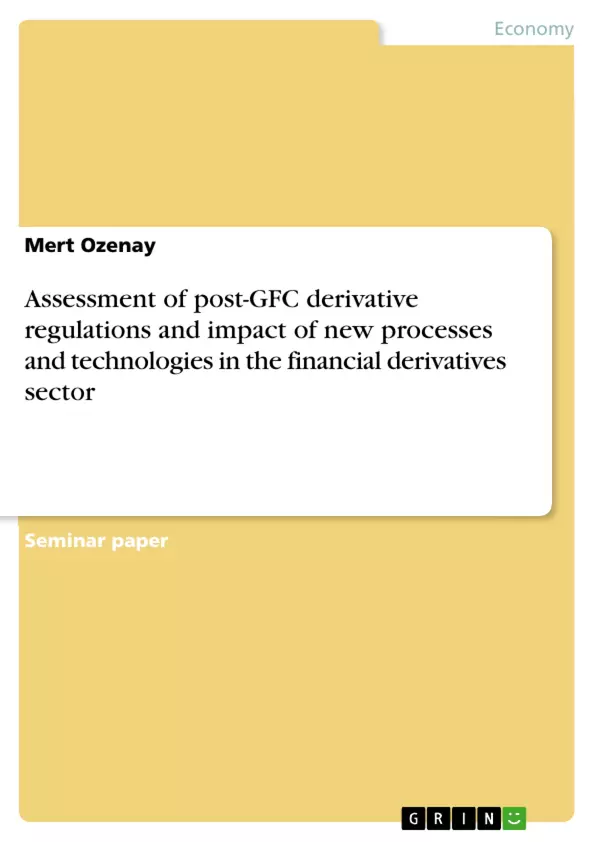The year 2008 marks one of the worst financial crises since the Great Depression. This market crisis has caused a paradigm shift in the global financial and capital markets. During the period between 2008 and 2012, a number of complications were seen in the markets, ultimately leading to a collapse of many institutions. Credit risk and complex securitized products were priced incorrectly and insufficient risk management functions amplified the scale of risks transmitted within multiple channels across the global markets. This paper addresses these developments and explores the current state of regulatory convergence. It furthermore seeks to understand the optimum level of regulatory convergence in the derivatives market and evaluates the developments in the global derivative markets.
The primary focus is not on critically evaluating the highly technical aspects of regulatory developments but rather on assessing the practical outcomes derived from such changes. In addition, this paper also seeks to find an answer to achieve transformative changes by setting effective policies across the EU and the US derivatives landscape.
This paper is furthermore focused on the more recent technological advancements which have a direct impact on derivative trading activities. Taking into consideration that innovation has tended to outpace regulation throughout history, it attempts to answer the question of regulating two selected innovations: smart derivative contracts and derivative security tokens.
Inhaltsverzeichnis (Table of Contents)
- Introduction
- Section 1: Overview of the Post-GFC Financial Derivatives Market
- Part 1: Financial Derivatives Market Observations and Trends
- Part 2: A Comparative Assessment of Regulatory Convergence Initiatives (EU-US Framework) and Global Harmonization Attempts in Financial Derivatives Market Regulations
- Section 2: Smart Derivative Contracts and Derivative Security Tokens- An Analysis of Selected New Processes and Technologies in the Financial Derivatives Market
- Part 1: Smart Derivative Contracts- the Legal Considerations and the Regulatory Governance Framework
- Part 2: Derivative Security Tokens- the Legal Considerations and the Regulatory Governance Framework
- Conclusion
Zielsetzung und Themenschwerpunkte (Objectives and Key Themes)
This paper explores the current state of regulatory convergence and attempts to understand the optimum level of regulatory convergence in the derivatives market. It also examines the developments in the global derivatives markets by comparing how regulations differ across various jurisdictions. The paper aims to achieve transformative changes by setting effective policies across the EU and US derivatives landscape. It explores the impact of new technologies and processes on derivatives trading activities, analyzing the challenges and opportunities presented by smart derivative contracts and derivative security tokens.
- Regulatory Convergence in the Derivatives Market
- Impact of New Technologies on Derivatives Trading
- Smart Derivative Contracts and their Regulatory Implications
- Derivative Security Tokens and their Regulatory Implications
- Comparative Analysis of Regulatory Frameworks across Jurisdictions
Zusammenfassung der Kapitel (Chapter Summaries)
The introduction provides context for the paper by discussing the global financial crisis of 2008 and its impact on the derivatives market. It highlights the importance of understanding derivatives and their role in financial innovation, particularly in the context of regulatory oversight.
Section 1 focuses on the post-GFC financial derivatives market. Part 1 discusses trends and observations within the derivatives market, while Part 2 delves into the comparative assessment of regulatory convergence initiatives and global harmonization efforts in financial derivatives market regulations, focusing on the EU-US framework.
Section 2 explores the influence of new processes and technologies within the financial derivatives market. It specifically examines the legal considerations and regulatory frameworks for smart derivative contracts and derivative security tokens.
Schlüsselwörter (Keywords)
Financial derivatives, regulatory convergence, global harmonization, smart contracts, derivative security tokens, systemic risk, post-GFC, EU regulations, US regulations, technological advancements, financial innovation.
- Citation du texte
- Mert Ozenay (Auteur), 2019, Assessment of post-GFC derivative regulations and impact of new processes and technologies in the financial derivatives sector, Munich, GRIN Verlag, https://www.grin.com/document/468586



